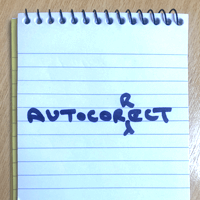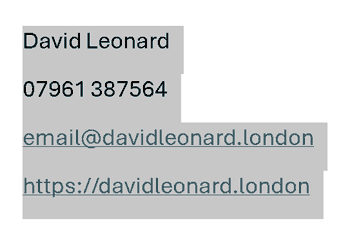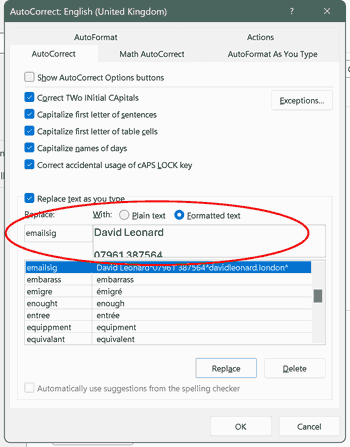
You can do more with autocorrect than just correct spelling and type fancy characters
In my blog post of 17/11/2023, I covered “re-setting Word options”. This included setting up your own autocorrect options so that, for instance, “thier” would automatically be changed to “their” every time you mis-type it.
Let’s be clear that this is you, the user, changing what “autocorrect” does in Microsoft programs. It’s not the autocorrect on a mobile phone that turns your text messages to gibberish.
What else can you do with autocorrect?
As well as automatically correcting your own habitual typing and spelling errors, and enabling the typing of special characters that do not appear on the keyboard, the autocorrect option in Word (and other Microsoft Office programs) can be used for other purposes such as:
- Typing your entire postal address
- Typing an email signature
Now, the problem with this is that these examples will entail typing on more than one line (see Figure 1). When you set up an autocorrect option as shown in my previous blog post there is no way to include the instruction to go down one line to print the second line (in old parlance, you can’t issue a “carriage return/line feed” instruction).
But – a little bit of lateral thinking can give you the answer (or you could just keep reading this post).
Using autocorrect to create muli-line text
Start by going to a blank area of a Word document (or an email, as autocorrect works just the same in the proper desktop version of Outlook as it does in Word) and then:

- Type your desired replacement text (eg an email signature that covers more than one line)
- Select (ie highlight) the entire replacement text that you have just created and place it in the clipboard (by typing “Ctrl c” without the quotes) – see Figure 1
- Go to the autocorrect options page as described in the earlier blog post
- Under the “replace” column, enter the desired text as before (eg “emailsig” – without the quotes)
- Under the “with” column, type “Ctrl v” to paste the contents of the clipboard (eg your email signature covering more than one line) – see Figure 2

Sorted! Every time you want to add your email signature to an email, just type “emailsig” (without the quotes). Just make sure when you are setting this up that the text that the autocorrect will replace is something unique that you wouldn’t want to type other than in this context.
Adding (random) capital letters with autocorrect
Another use for autocorrect is for people who are as pedantic as me and wish to type “iPhone” with a capital “P” but who get irritated by the fiddlyness of it all. Yes, I know, I devised an IT Tips service and called it “bITes“.
You know how to do it now – in autocorrect just enter that you wish to replace “iphone” with “iPhone” or “emailadd” with “FredBloggs@gmail.com”.
Three postscripts to this blog post:
- Some people very specifically state their email address including capital letters. In fact, although the email system is capable of differentiating between upper and lower case, it doesn’t do so. So, you can use whatever case you wish. The same is true of websites – “bbc.co.uk” is the same as “BBC.co.uk”. Including capital letters in email addresses and websites addresses can make them easier to read.
- There is a more sophisticated way of adding an email signature, but it is more complicated to get to grips with than the simple method described here.
- My use of “bITes” (digestible mouthfuls) is, of course, a pun on the computing terms “bits” and “bytes”. “bITes” is concerned with “IT” (Information Technology). Geddit?
PPS:
In case you don’t know your bits from your bytes, here’s a simple explanation:
Bit : Think of it like a light switch – on (1) or off (0). It’s the smallest piece of information a computer can understand.
Byte : Like a group of 8 of these switches working together. They can make more combinations (256 in total). These can be used to represent things such as letters or numbers – eg 00000010 might represent the number 2.